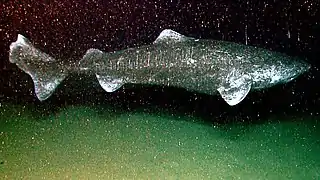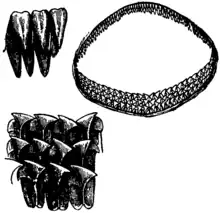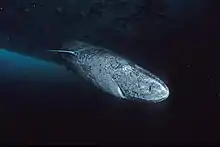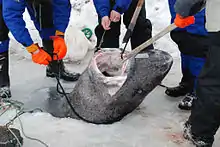Greenland shark
The Greenland shark (Somniosus microcephalus), also known as the gurry shark, grey shark, or by the Kalaallisut name eqalussuaq, is a large shark of the family Somniosidae ("sleeper sharks"), closely related to the Pacific and southern sleeper sharks.[2] The Greenland shark is a potentially important yet poorly studied cold-water species inhabiting the North Atlantic and Arctic Oceans.
| Greenland shark | |
|---|---|
 | |
| Scientific classification | |
| Domain: | Eukaryota |
| Kingdom: | Animalia |
| Phylum: | Chordata |
| Class: | Chondrichthyes |
| Order: | Squaliformes |
| Family: | Somniosidae |
| Genus: | Somniosus |
| Species: | S. microcephalus |
| Binomial name | |
| Somniosus microcephalus (Bloch & J. G. Schneider, 1801) | |
 | |
| Range of the Greenland shark | |
| Synonyms | |
| |
The Greenland shark has the longest known lifespan of all vertebrate species (estimated to be between 250 and 500 years),[3] and is among the largest extant species of shark. It is a generalist feeder, consuming a variety of available foods.[4] As an adaptation to living at depth,[5] it has a high concentration of trimethylamine N-oxide in its tissues, which causes the meat to be toxic.[6] Greenland shark flesh, treated to reduce toxin levels, is eaten in Iceland as a delicacy known as kæstur hákarl.[7] As it lives in the cold depths of the Arctic and North Atlantic, isolated from human activity, it is not known to be a threat to humans, and no attacks have been recorded.
Description
The Greenland shark is likely one of the largest living species of shark. It usually grows to between 2.4 and 7 m (7.9 and 23.0 ft) long and weighs between 400 and 1,400 kg (880 and 3,090 lb).[8][9][10][11]
Males are typically smaller than females. It rivals the Pacific sleeper shark (possibly up to 7 m or 23 ft long) as the largest species in the family Somniosidae. The Greenland shark is a thickset species, with a short, rounded snout, small eyes, and very small dorsal and pectoral fins. The gill openings are very small for the species' great size.
Coloration can range from pale creamy-gray to blackish-brown and the body is typically uniform in color, though whitish spots or faint dark streaks are occasionally seen on the back.[10]
Dentition

When feeding on large carcasses, the shark employs a rolling motion of its jaw. The 48 to 52 teeth of the upper jaw are very thin and pointed, lacking serrations. These upper jaw teeth act as an anchor while the lower jaw proceeds to cut massive chunks out of the prey.
The 48 to 52 lower teeth are interlocking, broad and square in shape, containing short, smooth cusps that point outward.[10] Teeth in the two halves of the lower jaw are strongly pitched in opposite directions.[12]
Behavior
Diet
The Greenland shark is an apex predator and eats mostly fish, although they have been observed actively hunting seals in Canada.[4] The prey found in the stomachs of Greenland sharks is an indicator of the active hunting patterns of these predators.[13] Recorded fish prey have included smaller sharks, skates, eels, herring, capelin, Arctic char, cod, rosefish, sculpins, lumpfish, wolffish, and flounder.[10] Small Greenland sharks eat predominantly squid, while the larger sharks that are greater than 200 cm (79 in) were discovered eating prey such as epibenthic and benthic fishes as well as seals. The largest of these sharks were found having eaten redfish, as well as other higher trophic level prey.[14]
Greenland sharks, because of their slow speeds, often hunt prey that are asleep. Using their cryptic coloration, they can approach prey undetected before closing the remaining distance by opening their large buccal cavity to create a suction that draws in the prey. This is the likely explanation for why the gut contents of Greenland sharks are often whole prey specimens.[13]
Greenland sharks have also been found with remains of seals, moose,[15] and reindeer (in one case an entire reindeer body) in their stomachs.[10][16] The Greenland shark is known to be a scavenger and is attracted by the smell of rotting meat in the water. The sharks have frequently been observed gathering around fishing boats.[10] They also scavenge on seals.[17]
Although such a large shark could easily consume a human swimmer, the frigid waters it typically inhabits make the likelihood of attacks on people very low. No cases of predation on humans have been verified.[10]
Movement
As an ectotherm living in a just-above-freezing environment, the Greenland shark has the lowest swim speed and tail-beat frequency for its size across all fish species, which most likely correlates with its very slow metabolism and extreme longevity.[18] It swims at 1.22 km/h (0.76 mph), with its fastest cruising speed only reaching 2.6 km/h (1.6 mph).[19] Because this top speed is a fraction of that of a typical seal in their diet, biologists are uncertain how the sharks are able to prey on the seals. It is hypothesized that they may ambush them while they sleep.[20]
Greenland sharks migrate annually based on depth and temperature rather than distance, although some do travel. During the winter, the sharks congregate in the shallows (up to 80° north) for warmth but migrate separately in summer to the deeps or even farther south. The species has been observed at a depth of 2,200 metres (7,200 ft) by a submersible investigating the wreck of the SS Central America that lies about 160 nautical miles (180 mi; 300 km) east of Cape Hatteras, North Carolina.[21] Daily vertical migration between shallower and deeper waters has also been recorded.[22]
In August 2013, researchers from Florida State University caught a Greenland shark in the Gulf of Mexico at a depth of 1,749 m (5,738 ft), where the water temperature was 4.1 °C (39.4 °F).[23] Four previous records of Greenland shark were reported from Cuba and the northern Gulf of Mexico.[24] A more typical depth range is 0–1,500 m (0–4,900 ft), with the species often occurring in relatively shallow waters in the far north and deeper in the southern part of its range.[25][26]
In April 2022, a large Somniosus shark was caught and subsequently released on Glover's Reef off the coast of Belize. This shark was identified as being either a Greenland shark or a Greenland/Pacific sleeper shark hybrid. This observation is notable for being the first possible record of a Greenland shark from the Western Caribbean, and being caught on a nearshore coral reef (the only other record of this species from the Caribbean was made from a deep-water habitat off the Caribbean coast of Colombia). The discovery indicates that Greenland sharks may have a wider distribution in the tropics, primarily at greater depths, than previously believed.[27]
Other behaviors
The shark is often infested by the copepod Ommatokoita elongata, a crustacean which attaches itself to the shark's eyes.[28] It was speculated that the copepod may display bioluminescence and thus attract prey for the shark in a mutualistic relationship, but this hypothesis has not been verified.[29] These parasites also damage the eyeball in several ways, leading to almost complete blindness. This does not seem to reduce the life expectancy or predatory ability of Greenland sharks, due to their strong reliance on smell and hearing.[28][30] The shark occupies what tends to be a very deep environment seeking its preferred cold water (−0.6 to 12 °C or 31 to 54 °F) habitat.[1]
When hoisted upon deck, it beats so violently with its tail, that it is dangerous to be near it, and the seamen generally dispatch it, without much loss of time. The pieces that are cut off exhibit a contraction of their muscular fibres for some time after life is extinct. It is, therefore, extremely difficult to kill, and unsafe to trust the hand within its mouth, even when the head is cut off. And, if we are to believe Crantz, this motion is to be observed three days after, if the part is trod on or struck.
— Henry William Dewhurst, The Natural History of the Order Cetacea (1834)[31]
Longevity
The Greenland shark has the longest known lifespan of all vertebrate species.[32] One Greenland shark was tagged off the coast of Greenland in 1936 and recaptured in 1952. Its measurements suggest that Greenland sharks grow at a rate of 0.5–1 cm (1⁄4–1⁄2 in) per year.[33] In 2016, a study based on 28 specimens that ranged from 81 to 502 cm (2 ft 8 in – 16 ft 6 in) in length used radiocarbon dating of crystals within the lenses of their eyes to determine their approximate ages. The oldest of the animals sampled, which was also the largest, had lived for 392 ± 120 years, and was consequently born between 1504 and 1744.[lower-alpha 1] The authors further concluded that the species reaches sexual maturity at about 150 years of age.[32][34][35] Efforts to conserve Greenland sharks are particularly important due to their extreme longevity, long maturation periods, and the heightened sensitivity of large shark populations.[36]
Reproduction
As recently as 1957, females were found not to deposit eggs in the bottom mud, but retain the developing embryos within their bodies so they are born alive (a process known as ovoviviparity) after an estimated gestation period of 8–18 years.[18] About ten pups per litter is normal, each initially measuring some 38–42 cm (15–16+1⁄2 in) in length.[34][37] Within a Greenland shark's uterus, villi serve a key function in supplying oxygen to embryos. It is speculated that due to embryonic metabolism dealing with reproduction, this only allows for a limited litter size of around 10 pups.[38] It has been estimated that due to their extreme longevity, Greenland sharks can have 200 to 700 pups during their lifetime.[18]
Physiological adaptations

Like other elasmobranchii, Greenland sharks have high concentrations of the two nitrogenous compounds urea and trimethylamine N-oxide (TMAO) in their tissues, which increase their buoyancy[39] and function as osmoprotectants. TMAO also counteracts the protein-destabilizing tendencies of urea[40][41] and deep-water pressure.[5][41] Its presence in the tissues of both elasmobranch and teleost fish has been found to increase with depth.[5][42]
The blood of Greenland sharks contains three major types of hemoglobin, made up of two copies of α globin combined with two copies of three very similar β subunits. These three types show very similar oxygenation and carbonylation properties, which are unaffected by urea, an important compound in marine elasmobranch physiology. They display identical electronic absorption and resonance Raman spectra, indicating that their heme-pocket structures are identical or highly similar. The hemoglobins also have a lower affinity for O2 compared to temperate sharks. These characteristics are interpreted as adaptations to living at great water depths.[43]
As food

The flesh of the Greenland shark is toxic because of the presence of high concentrations of trimethylamine oxide (TMAO). If the meat is eaten without pretreatment, the ingested TMAO is metabolized into trimethylamine, which may be a uremic toxin. Occasionally, sled dogs that eat the flesh are unable to stand up because of this effect. Similar toxic effects occur with the related Pacific sleeper shark, but not in most other shark species.[44][45]
The meat can be treated for safe consumption by boiling in several changes of water, drying, or fermenting for several months to produce kæstur hákarl. Traditionally, this is done by burying the meat in boreal ground for 6–8 weeks, which presses the TMAO out of the meat and also results in partial fermentation. The meat is then excavated and hung in strips to dry for several more months.[46] It is considered a delicacy in Iceland.[47][48][49]
Inuit legends
The Greenland shark's poisonous flesh has a high urea content, which gave rise to the Inuit legend of Skalugsuak, the first Greenland shark.[50] The legend says that an old woman washed her hair in urine (a common practice to kill head lice) and dried it with a cloth. The cloth blew into the ocean to become Skalugsuak.[51] Another legend tells of Sedna whose father cut off her fingers while drowning her, with each finger turning into a sea creature, including Skalugsuak.[52]
The Greenland shark plays a role in cosmologies of the Inuit from the Canadian Eastern Arctic and Greenland. Igloolik Inuit believe that the shark lives within the urine pot of Sedna, goddess of the sea, and consequently, its flesh has a urine-like smell and acts as a helping spirit to shamans.[53]
Ecological importance
Role in Arctic ecosystems
As both scavengers and active predators, Greenland sharks have established themselves as apex predators in Arctic ecosystems. They eat a wide variety of fish, seals, and other prey within these ecosystems and have an important role in the intricate food web.[13][14]
Conservation and management
Greenland sharks are recognized as the longest-lived vertebrates on earth. They have a slow growth rate, late maturity period, and low fecundity, making the management and conservation of this species very important. As a result of their low productivity and extreme longevity, this species is particularly susceptible to overfishing. Therefore, Greenland sharks' longevity and conservative life history traits, in tandem with their vulnerability to accidental catching and commercial fishing, promotes a growing concern for the sustainability of this species.[54]
Threats

The shark has historically been hunted for its liver oil up until the development of synthetic oils and cessation of export of liver oil and skin from Greenland in the 1960s.[55] In the 1970s, the species was perceived as a problem for other fisheries in western Norway and the government subsidized a fishery to reduce the stock of the species.[56]
Approximately 3,500 individuals are taken as bycatch each year in the Atlantic and Arctic Ocean and Barents Sea.[57] More than 1,000 individuals are caught annually from Arctic waters south to USA waters.[58] Annual catch of Greenland sharks from the Barents Sea was estimated to be around 1,200 individuals per year.[57][1]
The shark is likely affected by quantity, dynamics, and distribution of Arctic sea ice.[54] The rate of projected loss of sea ice will continue to negatively influence the abundance, distribution and availability of prey, while, at the same time, providing greater access for fishing fleets.[54] There is greater potential for new fisheries to develop as more productive and abundant southerly species invade the warming Arctic waters.[59][1]
Notes
- Lower-age estimage 392 − 120 = 272 years, and 2016 − 272 = 1744; higher age estimate 392 + 120 = 512 years, and 2016 − 512 = 1504.
References
- Kulka, D.W.; Cotton, C.F.; Anderson, B.; Derrick, D.; Herman, K.; Dulvy, N.K. (2020). "Somniosus microcephalus". IUCN Red List of Threatened Species. 2020: e.T60213A124452872. doi:10.2305/IUCN.UK.2020-3.RLTS.T60213A124452872.en. Retrieved 19 November 2021.
- Yano, Kazunari; Stevens, John D.; Compagno, Leonard J.V. (2004). "A review of the systematics of the sleeper shark genus Somniosus with redescriptions of Somniosus (Somniosus) antarcticus and Somniosus (Rhinoscymnus) longus (Squaliformes: Somniosidae)". Ichthyological Research. 51 (4): 360–373. doi:10.1007/s10228-004-0244-4. S2CID 38054192.
- "How long do Greenland sharks live?". National Ocean Service. Retrieved 2 June 2021.
- Nielsen, Julius; Hedeholm, Rasmus B.; Simon, Malene; Steffensen, John F. (1 January 2014). "Distribution and feeding ecology of the Greenland shark (Somniosus microcephalus) in Greenland waters". Polar Biology. 37 (1): 37–46. doi:10.1007/s00300-013-1408-3. ISSN 1432-2056. S2CID 17829168.
- Yancey, Paul H.; Gerringer, Mackenzie E.; Drazen, Jeffrey C.; Rowden, Ashley A.; Jamieson, Alan (2014). "Marine fish may be biochemically constrained from inhabiting the deepest ocean depths". Proceedings of the National Academy of Sciences of the United States of America. 111 (12): 4461–4465. Bibcode:2014PNAS..111.4461Y. doi:10.1073/pnas.1322003111. PMC 3970477. PMID 24591588.
- Anthoni, Uffe; Christophersen, Carsten; Gram, Lone; Nielsen, Niels H.; Nielsen, Per (1991). "Poisonings from flesh of the Greenland shark Somniosus microcephalus may be due to trimethylamine". Toxicon. 29 (10): 1205–1212. doi:10.1016/0041-0101(91)90193-U. PMID 1801314.
- Durst, Sidra (2012). "Hákarl". In Deutsch, Jonathan; Murakhver, Natalya (eds.). They Eat That? A cultural encyclopedia of weird and exotic food from around the world. pp. 91–92. ISBN 978-0-313-38059-4.
- Mills, Patrick (2006). Dewey, Tanya (ed.). "Somniosus microcephalus". Animal Diversity Web. University of Michigan.
- McClain, Craig R.; Balk, Meghan A.; Benfield, Mark C.; Branch, Trevor A.; Chen, Catherine; Cosgrove, James; et al. (13 January 2015). "Sizing ocean giants: patterns of intraspecific size variation in marine megafauna". PeerJ. 3: e715. doi:10.7717/peerj.715. PMC 4304853. PMID 25649000.
- Eagle, Dane. "Greenland shark". Florida Museum of Natural History. Archived from the original on 21 March 2013. Retrieved 26 June 2012.
- Wood, Gerald (1983). The Guinness Book of Animal Facts and Feats. ISBN 978-0-85112-235-9.
- "Greenland Shark". Marinebiodiversity.ca. Centre for Marine Biodiversity. Archived from the original on 3 April 2014. Retrieved 23 May 2011.
- Lydersen, Christian; Fisk, Aaron T.; Kovacs, Kit M. (November 2016). "A review of Greenland shark (Somniosus microcephalus) studies in the Kongsfjorden area, Svalbard Norway". Polar Biology. 39 (11): 2169–2178. doi:10.1007/s00300-016-1949-3. ISSN 0722-4060. S2CID 15050012.
- Nielsen, Julius; Christiansen, Jørgen Schou; Grønkjær, Peter; Bushnell, Peter; Steffensen, John Fleng; Kiilerich, Helene Overgaard; et al. (2019). "Greenland shark (Somniosus microcephalus) stomach contents and stable isotope values reveal an ontogenetic dietary shift". Frontiers in Marine Science. 6. doi:10.3389/fmars.2019.00125. ISSN 2296-7745.
- "Moose-eating shark rescued in Newfoundland harbour". CBC News. 21 November 2013. Retrieved 21 November 2013.
- Howden, Daniel (12 August 2008). "Clash of the fiercest predators as shark eats polar bear". The Independent. Retrieved 26 June 2012.
- Yong, Ed (11 August 2016). "The sharks that live to 400". The Atlantic. Retrieved 15 August 2016.
- Augustine, Starrlight; Lika, Konstadia; Kooijman, Sebastiaan A.L.M. (1 December 2017). "Comment on the ecophysiology of the Greenland shark, Somniosus microcephalus" (PDF). Polar Biology. 40 (12): 2429–2433. doi:10.1007/s00300-017-2154-8. hdl:1871.1/a6f1d885-5cd1-431f-8e85-540060915b6c. ISSN 1432-2056. S2CID 20852421.
- Watanabe, Yuuki Y.; Lydersen, Christian; Fisk, Aaron T.; Kovacs, Kit M. (2012). "The slowest fish: Swim speed and tail-beat frequency of Greenland sharks". Journal of Experimental Marine Biology and Ecology. 426–427: 5–11. doi:10.1016/j.jembe.2012.04.021.
- Scales, Helen (June 2012). "Slow sharks sneak up on sleeping seals (and eat them)?". National Geographic News. Retrieved 28 December 2012.
- "America's lost treasure". sscentralamerica.com. Archived from the original on 24 November 2016. Retrieved 14 February 2017.
- Owen, D. (2009). Shark: In peril in the sea. Allen & Unwin.
- Grubs, Dean (15 August 2013). "Deep-C Scientists Capture First Greenland Shark in the Gulf of Mexico". deep-c.org
- Benfield, Mark (2008). "The second report of a sleeper shark (Somniosus (Somniosus) sp.) from the bathypelagic waters of the northern Gulf of Mexico". Bulletin of Marine Science. 82 (2): 195–198.
- Yano, K.; Stevens, J.D.; Compagno, L.J.V. (2007). "Distribution, reproduction and feeding of the Greenland shark Somniosus (Somniosus) microcephalus, with notes on two other sleeper sharks, Somniosus (Somniosus) pacificus and Somniosus (Somniosus) antarcticus". Journal of Fish Biology. 70 (2): 374–390. doi:10.1111/j.1095-8649.2007.01308.x.
- Møller, P.R.; Nielsen, J.; Knudsen, S.W.; Poulsen, J.Y.; Sünksen, K.; Jørgensen, O.A. (2010). "A checklist of the fish fauna of Greenland waters". Zootaxa. 2378 (1): 1–84.
- Kasana, Devanshi; Martinez, Hector Daniel; Faux, Omar; Monzon, Neri; Guerra, Elio; Chapman, Demian D. (2022). "First report of a sleeper shark (Somniosus sp.) in the western Caribbean, off the insular slope of a coral atoll". Marine Biology. 169 (8). doi:10.1007/s00227-022-04090-3. S2CID 250590599. Retrieved 30 July 2022.
- Borucinska, J.D.; Benz, G.W.; Whiteley, H.E. (1998). "Ocular lesions associated with attachment of the parasitic copepod Ommatokoita elongata (Grant) to corneas of Greenland sharks, Somniosus microcephalus (Bloch & Schneider)". Journal of Fish Diseases. 21 (6): 415–422. doi:10.1046/j.1365-2761.1998.00122.x.
- Berland, Bjørn (1961). "Copepod Ommatokoita elongata (Grant) in the eyes of the Greenland shark – a possible cause of mutual dependence". Nature. 191 (4790): 829–830. Bibcode:1961Natur.191..829B. doi:10.1038/191829a0. S2CID 4262630.
- Ferrando, S.; Gallus, L.; Ghigliotti, L.; Vacchi, M.; Nielsen, J.; Christiansen, J.S.; Pisano, E. (1 August 2016). "Gross morphology and histology of the olfactory organ of the Greenland shark Somniosus microcephalus". Polar Biology. 39 (8): 1399–1409. doi:10.1007/s00300-015-1862-1. ISSN 1432-2056. S2CID 17368573.
- Dewhurst, H.W. (1834). The Natural History of the Order Cetacea and the Oceanic Inhabitants of the Arctic Regions. Verf.
Illustrated with numerous lithographic and wood engravings
- Nielsen, Julius; Hedeholm, Rasmus B.; Heinemeier, Jan; Bushnell, Peter G.; Christiansen, Jørgen S.; Olsen, Jesper; et al. (2016). "Eye lens radiocarbon reveals centuries of longevity in the Greenland shark (Somniosus microcephalus)". Science. 353 (6300): 702–704. Bibcode:2016Sci...353..702N. doi:10.1126/science.aaf1703. hdl:2022/26597. PMID 27516602. S2CID 206647043.
de Lazaro, Enrico (12 August 2016). "Greenland sharks are longest-lived vertebrates on Earth, marine biologists say". Science News. - Caloyianis, Nick (September 1998). "Greenland Sharks". National Geographic. 194 (3): 60–71.
- Pennisi, Elizabeth (11 August 2016). "Greenland shark may live 400 years, smashing longevity record". Science. doi:10.1126/science.aag0748.
- O'Connor, M.R. (25 November 2017). "The strange and gruesome story of the Greenland shark, the longest-living vertebrate on Earth". The New Yorker. Retrieved 27 November 2017.
- Davis, Brendal; van der Zwaag, David L.; Cosandey-Godin, Aurelie; Hussey, Nigel E.; Kessel, Steven T.; Worm, Boris (1 October 2013). "The conservation of the Greenland shark (Somniosus microcephalus): Setting scientific, law, and policy coordinates for avoiding a species at risk". Journal of International Wildlife Law & Policy. 16 (4): 300–330. doi:10.1080/13880292.2013.805073. ISSN 1388-0292. S2CID 84039070.
- Martin, R. Aidan. "Greenland shark". elasmo-research.org. Retrieved 23 May 2011.
- Carter, Anthony M.; Soma, Hiroaki (1 August 2020). "Viviparity in the longest-living vertebrate, the Greenland shark (Somniosus microcephalus)". Placenta. 97: 26–28. doi:10.1016/j.placenta.2020.05.014. PMID 32792058. S2CID 221121663.
- Withers, Philip C.; Morrison, Garrick; Guppy, Michael (1994). "Buoyancy Role of Urea and TMAO in an Elasmobranch Fish, the Port Jackson Shark, Heterodontus portusjacksoni". Physiological Zoology. 67 (3): 693–705. doi:10.1086/physzool.67.3.30163765. JSTOR 30163765. S2CID 100989392.
- Bennion, Brian J.; Daggett, Valerie (2004). "Counteraction of urea-induced protein denaturation by trimethylamine N-oxide: a chemical chaperone at atomic resolution". Proceedings of the National Academy of Sciences of the United States of America. 101 (17): 6433–6438. Bibcode:2004PNAS..101.6433B. doi:10.1073/pnas.0308633101. PMC 404062. PMID 15096583.
- Yancey, Paul H. (2005). "Organic osmolytes as compatible, metabolic and counteracting cytoprotectants in high osmolarity and other stresses". The Journal of Experimental Biology. 208 (pt 15): 2819–2830. doi:10.1242/jeb.01730. PMID 16043587.
- Treberg, Jason R.; Driedzic, William R. (2002). "Elevated levels of trimethylamine oxide in deep-sea fish: Evidence for synthesis and intertissue physiological importance". Journal of Experimental Zoology. 293 (1): 39–45. doi:10.1002/jez.10109. PMID 12115917.
- Russo, Roberta; Giordano, Daniela; Paredi, Gianluca; Marchesani, Francesco; Milazzo, Lisa; Altomonte, Giovanna; et al. (12 October 2017). "The Greenland shark Somniosus microcephalus — hemoglobins and ligand-binding properties". PLOS ONE. 12 (10): e0186181. Bibcode:2017PLoSO..1286181R. doi:10.1371/journal.pone.0186181. PMC 5638460. PMID 29023598.
- "The Greenland shark is a very odd species of shark". Shark Sider. December 2014. Retrieved 17 August 2016.
- "The Greenland shark: An icy mystery". Sharkopedia. Discovery.com. Archived from the original on 7 January 2018. Retrieved 17 August 2016.
- Wheatley, Gale (20 September 2010). "Iceland's wild culinary traditions: Hákarl and brennivín". gourmetwonderland.com. Archived from the original on 6 March 2014. Retrieved 12 August 2016.
- Blumenfeld, Jenna (16 June 2011). "My encounter with hákarl, the worst tasting food on Earth". theexpeditioner.com. Archived from the original on 8 July 2015. Retrieved 7 July 2015.
- "Hákarl – Icelandic fermented shark". Islands. Retrieved 13 August 2016.
- Shardlow, Ju; Romeo, Claudia. "Greenland shark is the most toxic shark in the world, but one family has been curing it for hundreds of years". Insider. Retrieved 23 January 2022.
- O'Reilly, Lindsay (2004). "Skalugsuak's origins". Canadian Geographic. Archived from the original on 21 March 2016. Retrieved 13 August 2016.
- "Greenland shark". Greenland Shark and Elasmobranch Education and Research Group. Archived from the original on 14 October 2013. Retrieved 13 August 2016.
- Helfman, Gene; Burgess, George H. (2014). Sharks: The animal answer guide. Johns Hopkins University Press.
- Idrobo, Carlos Julián (February 2009). The Pangnirtung Inuit and the Greenland Shark (PDF) (M.Sc. thesis). University of Manitoba. p. 66. OCLC 855389661.
- Edwards, Jena E.; Hiltz, Elizabeth; Broell, Franziska; Bushnell, Peter G.; Campana, Steven E.; Christiansen, Jørgen S.; et al. (2 April 2019). "Advancing research for the management of long-lived species: A case study on the Greenland shark". Frontiers in Marine Science. 6: 87. doi:10.3389/fmars.2019.00087. ISSN 2296-7745.
- Hedeholm et al. 2018
- Castro et al. 1999
- Rusyaev and Orlov 2013
- Bryk et al. 2018, Hedeholm et al. 2018, Hendrickson 2018, Hendrickson et al. 2018, Simpson et al. 2018, Wheeland and Devine 2018.
- Tai et al. 2019
Further reading
- MacNeil, M.A.; McMeans, B. C.; Hussey, N. E.; Vecsei, P.; Svavarsson, J.; Kovacs, K. M.; Lydersen, C.; Treble, M.A.; et al. (2012). "Biology of the Greenland shark Somniosus microcephalus". Journal of Fish Biology. 80 (5): 991–1018. doi:10.1111/j.1095-8649.2012.03257.x. PMID 22497371.
- Watanabe, Yuuki Y.; Lydersen, Christian; Fisk, Aaron T.; Kovacs, Kit M. (2012). "The slowest fish: Swim speed and tail-beat frequency of Greenland sharks". Journal of Experimental Marine Biology and Ecology. 426–427: 5–11. doi:10.1016/j.jembe.2012.04.021.
- Jeanna Bryner (25 June 2012). "Sea's slowest sharks snack on sleeping seals". LiveScience.
- Herbert, N.A.; Skov, P.V.; Tirsgaard, B.; Bushnell, P.G.; Brill, R.W.; Harvey Clark, C.; Steffensen, J.F. (2017). "Blood O2 affinity of a large polar elasmobranch, the Greenland shark Somniosus microcephalus". Polar Biology. 40 (11): 2297–2305. doi:10.1007/s00300-017-2142-z. S2CID 206954171.
- Shadwick, R.E.; Bernal, D.; Bushnell, P.G.; Steffensen, J.F. (2018). "Blood pressure in the Greenland shark as estimated from ventral aortic elasticity". Journal of Experimental Biology. 221 (Pt 19). doi:10.1242/jeb.186957. PMID 30104302. S2CID 51976050.
- Nielsen, J.; Schou Christiansen, J.; Grønkjær, P.; Bushnell, P.G.; Steffensen, J.F.; Overgaard Kiilerich, H.; et al. (2019). "Greenland shark (Somniosus microcephalus) stomach contents and stable isotope values reveal an ontogenetic dietary shift". Marine Megafauna. Frontiers in Marine Science. 6. doi:10.3389/fmars.2019.00125.
- Nielsen, J.; Hedeholm, R.B.; Lynghammar, A.; McClusky, L.M.; Berland, B.; Steffensen, J.F.; Christiansen, J.S. (2020). "Assessing the reproductive biology of the Greenland shark (Somniosus microcephalus)". PLOS ONE. 15 (10): e0238986. Bibcode:2020PLoSO..1538986N. doi:10.1371/journal.pone.0238986. PMC 7540863. PMID 33027263.
External links
- Greenland Shark and Elasmobranch Education and Research Group
- Canadian Museum of Nature SV Greenland Shark
- "Somniosus microcephalus". Integrated Taxonomic Information System. Retrieved 23 January 2006.
- Froese, Rainer; Pauly, Daniel (eds.) (2006). "Somniosus microcephalus" in FishBase. May 2006 version.
- "Greenland Shark" on As It Happens 6 May 2008; CBC Radio 1(WMV file)
- Greenland shark – Video on Check123
- Old and Cold: Biology of the Greenland shark - project at Univ Copenhagen - http://mbl.ku.dk/JFSteffensen/OldAndCold/
- Old and Cold: Biology of the Greenland shark - project on ResearchGate
